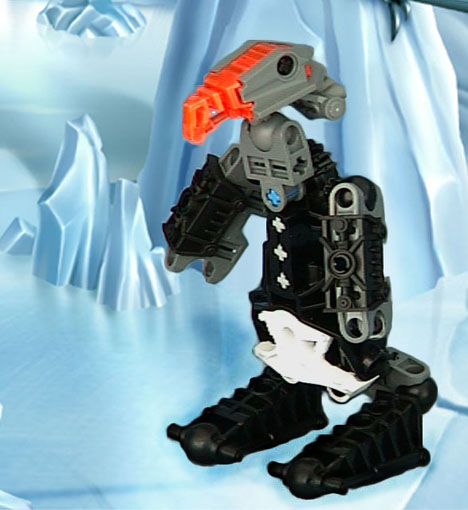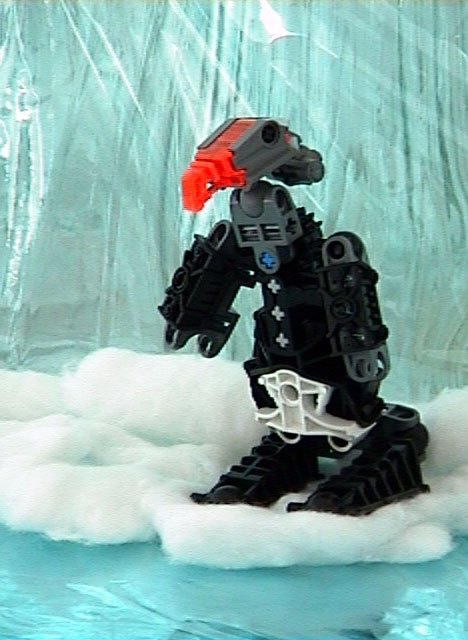
The Opui are flightless seabird Rahi that spend most of their lives hunting in the frigid waters off the coast of Ko-Metru. Each year they nest on shore. It is not unusual to see an Opui wandering around the lower levels of a Knowledge Tower in search of nesting materials.
That was my 50-word essay that accompanied my entry to the LEGO® BIONICLE® Rahi Building Challenge . Fifty words is not much to tell “all about your Rahi, where in Metru Nui it lives, whether it is friendly or dangerous, and any other important facts about it.” Considering the essay was 25% of the contest, in retrospect I wish I had submitted this haiku instead:
Flightless Metru Nui bird,
Lives off Ko-Metru.
As you can see, a haiku is only slightly more restrictive than a fifty word limit. Let’s hope for five-hundred words next time.
I set out to create a Metru Nui penguin from the very moment I first read about the contest. Penguins are perhaps my favorite animal. I chose Opui for my penguin’s name in honor of Opus from Berkeley Breathed ‘s comic strip Bloom County .
I was inspired by TOA NOKAMA’s “hydro blades” as flippers. Unfortunately, the blades are much too large for the scale I wanted to work in, so they are not in the final model. I was aiming for a model that would work next to a TOA METRU.
Although I started out using pieces from my entire, voluminous collection of BIONICLE sets, something funny happened on the way to the contest. Ignoring color, the finished model can be made using parts from just one TOA METRU set with blue pin/axle connectors (all but ONEWA and NUJU). As entered, the Opui uses parts mostly from TOA WHENUA, with only a chest plate from TOA NUJU and TOA NOKAMA’s eyes substituted for WHENUA’s. Oh, and I added one optional grey 3-length axle. You can knock me on creativity (25%) for submitting what is essentially a TOA METRU turned upside-down and backward, but that is what I ended up with, not what I started out with.
I would have preferred an entry using a computer-generated background like the composite picture above, but the rules specifically forbade “computer printouts”. That’s a shame too, because in this day of digital photography what constitutes a “computer printout” is subject to a great deal of interpretation. If I take a digital photo and have it printed to photo paper by the same one-hour photo machine as prints my film pictures, is that a “computer printout”? What if I color-correct it on my PC in between the camera and the printer?
My official entry looked more like this:

The background is supposed to look like a glacier or icy Knowledge Tower of Ko-Metru, and the foreground is a little snowy ledge by the water/liquid protodermis. The “glacier” is constructed of glass vases draped in blue plastic wrap, the snow is obviously cotton balls, and the “water” is aluminum foil covered by more blue plastic wrap. The scene was an attempt to recoup some creativity points.
I don’t know how the Opui stands on originality (50%). There may have been thousands of penguins submitted for all I know. I’ll venture that there were fewer penguins than scorpions though, a very popular entry in our very own “Bug Week!” Contest .
If you would like to make your own Opui, here is how it is constructed. Take TOA WHENUA and remove his shins, ankles and feet. Move his pelvis down out of his torso one notch, leaving just one hole showing. Remove his chestplate, gears, gear pin, and entire arm assemblies. Remove his neck and head. Now flip him upside-down.
Replace WHENUA’s chestplate with NUJU’s chestplate and add a third 3-length grey axle to what is now the Opui’s chest. At this point, you should have the Opui torso and upper flippers. To attach the lower flippers/feet to the Opui, you will need to use one of WHENUA’s dark grey upper arm pieces centered at the bottom of the torso and connected using a blue pin/axle connector. WHENUA’s shins are connected to the sockets so that what were knees are now toes. The Opui needs to lean forward slightly on flat surfaces to maintain its balance.
That just leaves the head, which should be obvious from the pictures. Connect the head and neck assembly to the torso using a blue pin/axle connector. TOA NOKAMA’s backwards eyes become the Opui’s beak, and the black axle holding it in becomes the Opui’s eyes.
0 Comments